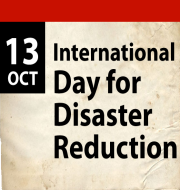October 13: International Day for Disaster Reduction
The International Day for Disaster Reduction (IDDR) is observed annually on 13 October across the world encourage citizens and governments to take part in building more disaster resilient communities and nations.
Significance of the day: It seeks to spread awareness about reining the risks of disasters around the world and also reduce exposure of people and communities to disasters.
2016 Theme: “Live to Tell: Raising Awareness, Reducing Mortality”.
The 2016 edition of IDDR marks the launch of the new Sendai Framework for Disaster Risk Reduction by United Nations Office for Disaster Risk Reduction (UNISDR). UNISDR’s campaign for the day is Sendai Seven that seeks to create a wave of awareness about actions taken to reduce mortality around the world.
Background
The International Day for Disaster Reduction was instituted by UN General Assembly (UNGA) in 1989 to promote a global culture of risk-awareness and disaster reduction. Earlier, this day was celebrated annually on the second Wednesday of October. But in 2009, the UNGA formally designated 13 October as the annual date by adopting Resolution 64/200.
What is Sendai Framework?
- The Sendai Framework is a 15-year voluntary, non-binding agreement which recognizes that the countries have the primary role to reduce disaster risk.
- It also recognises that this responsibility of countries should be shared with other stakeholders including local government, private sector and other stakeholders.
- It is the successor agreement to the Hyogo Framework for Action (2005–2015), which was the most encompassing international accord on disaster risk reduction to date.
- The Sendai Framework also seeks to promote best practices at the international, regional and national level across all sectors, to reduce disaster risk and disaster losses. The framework has seven targets and first of it is reducing disaster mortality.
- The four priority themes of the Sendai Framework are: (i) Understanding disaster risk, (ii) improving disaster risk governance, (iii) investing in disaster risk reduction (through structural and non-structural measures) and (iv) disaster preparedness, early warning and building back better in the aftermath of a disaster.
Month: Current Affairs - October, 2016



